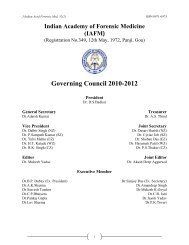Download - forensic medicine
Download - forensic medicine
Download - forensic medicine
Create successful ePaper yourself
Turn your PDF publications into a flip-book with our unique Google optimized e-Paper software.
Contradictory Skull and Age Estimation<br />
*Dr. Akhilesh Pathak, **Dr. H.M. Mangal<br />
* Assistant Professor, Department of Forensic Medicne, PDU Medical College, Rajkot.<br />
** Professor & Head, Department of Forensic Medicne, PDU Medical College, Rajkot.<br />
Corresponding Author: -<br />
Dr. Akhilesh Pathak<br />
Assistant Professor,<br />
Department of Forensic Medicine,<br />
PDU Medical College,<br />
Rajkot.(Gujarat)<br />
E-mail: dr.akhilesh_pathak@yahoo.co.in<br />
JIAFM, 2007 - 29(4); ISSN: 0971-0973<br />
Abstract<br />
The corpus delicti means the facts of any criminal offence. The main part of the corpus delicti is the establishment<br />
of identity of the dead body and infliction of violence in a particular way, at a particular time and place, by the<br />
person on persons charged with the crime and none other. The case against the accused cannot be established<br />
unless there is convincing proof of these points. If the victim’s identity is not known, it becomes difficult for the<br />
police to solve the crime. Determination of the age of the individual comes in routine <strong>forensic</strong> practice, as the age<br />
of the victim is one of the three primary characteristics of identification. But in few cases it is not easy to opine<br />
about the age of the victim especially when we are receiving only a single bone like skull with contradictory<br />
findings. The presented case report is an attempt to discuss that how we can solve such problems by considering<br />
the other criteria’s for age estimation in skull which can be of a great use when some contradictory findings are<br />
there in remains of skeleton.<br />
Key words: Skeletal remains, Age, and Identification.<br />
Introduction:<br />
Forensic identifications by their nature are<br />
multidisciplinary team efforts relying on positive<br />
identification methodologies as well as presumptive<br />
or exclusionary methodologies. Typically, this effort<br />
involves the cooperation and coordination of law<br />
enforcement officials, <strong>forensic</strong> experts, serologists<br />
and other specialists as deemed necessary. In each<br />
discipline, there is the need to develop scientific<br />
evidence relative to the questions of fact regarding<br />
identification in a defensible manner grounded on<br />
general rules of acceptance, reliability and<br />
relevance. In the <strong>forensic</strong> <strong>medicine</strong>, a great deal of<br />
effort is spent on the identity or confirmation of<br />
identity of the victim and perpetrator. This labor<br />
intensive aspect of a medicolegal examination<br />
focuses on the expertness to decide whether the<br />
remains are human or animal, and once it is decided<br />
that the remains are human in origin then we can<br />
proceed further to estimate the other data like age,<br />
sex and stature which contribute in identification.<br />
The experienced <strong>forensic</strong> pathologist considers a<br />
range of the available features and techniques<br />
before reaching a conclusion as multiple indicators<br />
are having the key role.<br />
Case history:<br />
In July 2007, a young male of 16 years age was<br />
kidnapped by his friends for the purpose of ransom<br />
and to hide their identification the kidnappers killed<br />
him and disposed off the body in a jungle. Police<br />
detained the suspects and during interrogation they<br />
accepted the crime committed. The skull and few<br />
pieces of long bones of the victim were recovered<br />
from the scene of crime as told by the accuse party<br />
and were brought to us for the postmortem<br />
examination. After examination we found that the<br />
bones were human in origin, belonged to one and<br />
the same individual and skull was showing male<br />
characteristic features. When we examined the skull<br />
to determine the age we got surprised to see that<br />
the third molars were not erupted in upper jaw<br />
bilaterally, while the skull sutures were completely<br />
fused on outer as well as on inner tables. The dental<br />
examination was showing that the skull is of a young<br />
adult of age between 12-17 years, while the fused<br />
skull sutures were indicating its older age. The<br />
suspicion was corrected by considering the other<br />
criteria of skull for age determination and finally we<br />
reached on a conclusion that the skull belongs to an<br />
individual of age between 12-17 years, which was<br />
also corresponding with the victim’s age as identified<br />
later. The criteria which were suggesting the<br />
younger age of the skull are as following:<br />
1. The contour of the skull was smooth and<br />
invorine on both inner and outer surfaces.<br />
129




![syllabus in forensic medicine for m.b.b.s. students in india [pdf]](https://img.yumpu.com/48405011/1/190x245/syllabus-in-forensic-medicine-for-mbbs-students-in-india-pdf.jpg?quality=85)



![SPOTTING IN FORENSIC MEDICINE [pdf]](https://img.yumpu.com/45856557/1/190x245/spotting-in-forensic-medicine-pdf.jpg?quality=85)

![JAFM-33-2, April-June, 2011 [PDF] - forensic medicine](https://img.yumpu.com/43461356/1/190x245/jafm-33-2-april-june-2011-pdf-forensic-medicine.jpg?quality=85)



![JIAFM-33-4, October-December, 2011 [PDF] - forensic medicine](https://img.yumpu.com/31013278/1/190x245/jiafm-33-4-october-december-2011-pdf-forensic-medicine.jpg?quality=85)

